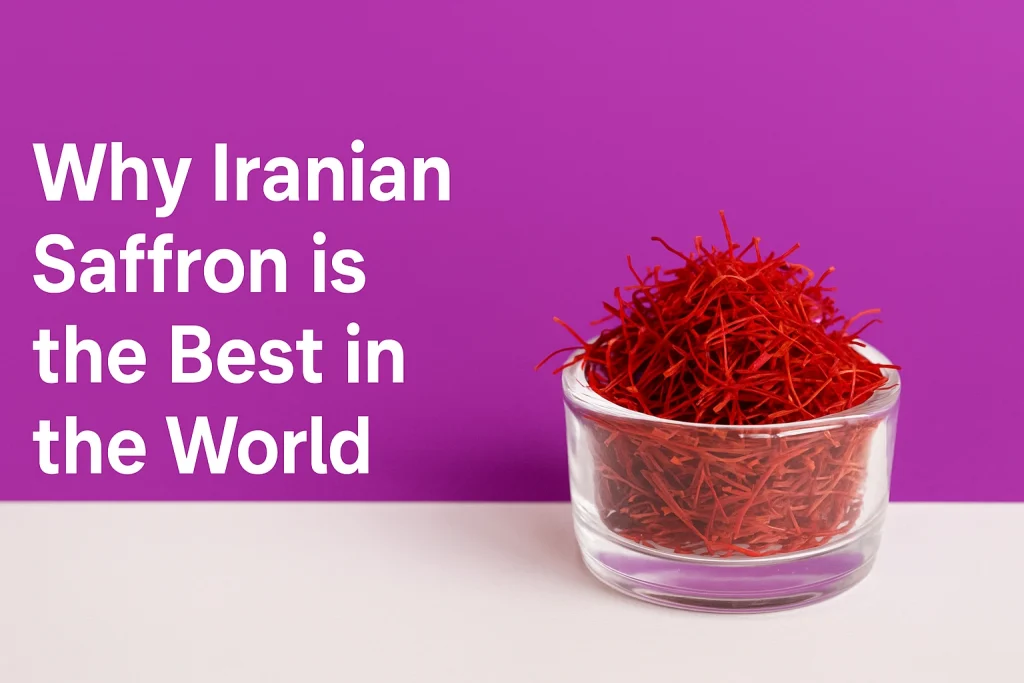Iranian saffron—often dubbed “red gold”—is the crown jewel of the spice world. With over 90% of the world’s saffron production originating in Iran, this country’s ancient practices, unique climate, and deep cultural reverence for the spice have positioned it as the global leader in saffron cultivation.
In this comprehensive 3000-word article, we explore why Iranian saffron remains unmatched in terms of quality, potency, and international recognition.
1. Iran’s Unique Climate and Geography
Iran’s saffron belt includes regions like Khorasan, Birjand, Torbat, and Qaenat—areas known for their arid conditions, hot days, and cool nights. These environmental conditions are ideal for Crocus sativus, the saffron-producing flower.
Key Factors:
- Well-drained sandy soil
- High-altitude fields (1200–2300 meters above sea level)
- Low humidity and minimal rainfall
These elements ensure that Iranian saffron is vibrant in color, high in essential oils, and rich in active compounds.
2. Superior Chemical Composition
Iranian saffron is known to score higher in international tests measuring:
- Crocin (responsible for coloring)
- Picrocrocin (responsible for flavor)
- Safranal (responsible for aroma)
ISO 3632 Standard
This global benchmark rates saffron quality based on lab analysis. Most Iranian saffron exports fall within Category I (highest grade), with crocin levels often exceeding 250.
According to the Iranian Saffron Export Development Fund, top-grade Persian saffron contains:
- Crocin: 260–280
- Picrocrocin: 90–110
- Safranal: 30–50
These levels ensure strong coloring, potent flavor, and long-lasting aroma.
3. Traditional Farming and Harvesting Methods
Unlike mechanized farming in other countries, saffron cultivation in Iran is largely done by hand. This careful approach minimizes stigma damage and enhances quality.
Manual Practices:
- Corm planting done in late summer
- Flower picking during sunrise to avoid sunlight damage
- Manual separation of stigmas from flowers
- Natural drying under shade or low heat
These traditional methods are not only sustainable but also produce saffron that retains its natural properties.
4. Cultural Heritage and Expertise
Saffron farming in Iran isn’t just agriculture—it’s a centuries-old art passed through generations. Farmers take pride in mastering:
- Optimal harvest timing
- Sorting based on stigma thickness and color
- Creating traditional product formats like “Dasteh” or “Pushal”
Iran also hosts annual saffron festivals and academic research centers focused solely on saffron science and trade, further cementing its global authority.
5. Government Standards and Export Infrastructure
Iran has developed dedicated standards for saffron cultivation, packaging, and export. These include:
- Government-regulated grading systems
- Advanced quality control labs (public & private)
- Specialized saffron export terminals in Mashhad and Tehran
Additionally, Iran’s Ministry of Agriculture, in collaboration with ISO, ensures that only top-grade saffron reaches global markets.
Comparison with Other Countries
While other countries also produce saffron—like Spain, Afghanistan, India, and Morocco—none match Iran in terms of chemical strength, volume, and tradition.
Quick Comparison Table:
| Feature | Iran | Spain | Afghanistan | India |
|---|---|---|---|---|
| Crocin Level (avg.) | 250–280 | 190–210 | 220–230 | 180–200 |
| Manual Harvest | ✔️ | ❌ | ✔️ | ❌ |
| Export Volume (2023) | 390 tons | 45 tons | 22 tons | 15 tons |
| Avg. Price per gram (USD) | $5–$10 | $7–$12 | $4–$6 | $3–$5 |
This data underscores Iran’s lead both in quantity and quality.
How Iranian Saffron Impacts Global Markets
With wide use in:
- Pharmaceuticals (as a natural antidepressant)
- Food and beverage industries
- Cosmetics and skincare
Iranian saffron is not just a cultural symbol but a global commodity with serious economic impact.
Many global brands source exclusively from Iran due to the consistent quality and availability.
Challenges and Sanctions: Still on Top
Despite facing trade sanctions, currency fluctuations, and political hurdles, Iran has retained its dominance in the global saffron market. Private exporters have adapted by:
- Partnering with overseas packaging facilities
- Creating joint ventures
- Participating in international fairs and exhibitions
Explore the Different Types of Saffron and Their Uses
Final Thoughts
Iranian saffron’s dominance is no accident—it’s the result of perfect natural conditions, centuries of experience, meticulous cultivation, and scientific superiority. From the fields of Khorasan to high-end kitchens in Europe, Persian saffron remains a timeless treasure.
Whether you’re a wholesaler, chef, or wellness brand, sourcing from Iran means getting the world’s best—period.

